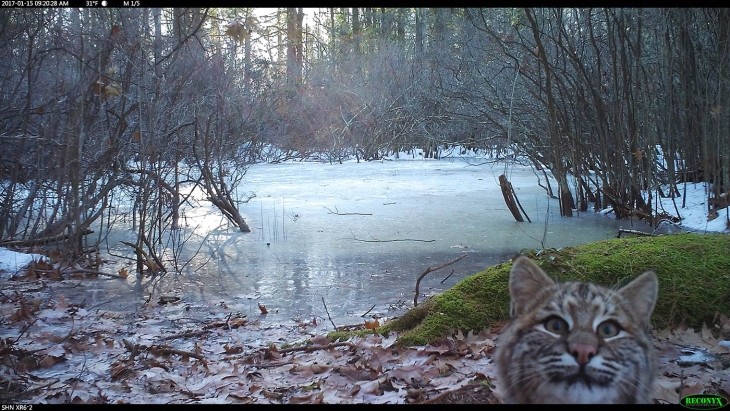
Nine years ago, I set up my first wildlife camera next to an active beaver pond on a conservation property a mile from my house. On the advice of an ecologist friend, I waited three weeks to return to the camera to check the SD card. When I finally did, I was rewarded with photos of a bobcat strolling by my camera, using the same trail I had used. With that, my wildlife camera addiction was born. Whether you call them game cameras, camera traps, or wildlife cameras, these devices provide us with a window into the lives of our wildlife neighbors.
Since that first experience, I’ve acquired more than 40 wildlife cameras and engaged in plenty of trial and error to capture both still images and videos. When recommending a camera – or placement – I ask three basic questions: What are your wildlife photography goals? What is your budget? Are there black bears where you plan to set up your camera?
Wildlife Camera Considerations
When shopping for a camera, the sheer number of different brands and models can be overwhelming. The good news is that you can get a good-quality, dependable camera for less than $150, or a cellular camera for less than $200 (plus an additional monthly cost for a data plan). A cellular camera works on a data plan and allows users to view images and videos through their smartphones – without having to return to the camera location.
When deciding on a camera, consider which types of wildlife you’d like to capture, where and how you’ll set up the camera, and which type of flash will work best. Trigger speed (how quickly the camera activates) and recovery time are also important considerations. Most cameras less than $200 will have a trigger speed of less than 0.5 seconds, which will allow for great photos.
For those who primarily want to capture videos, I recommend a model with a minimum resolution of 1080 pixels. Capturing videos provides greater insight into wildlife behaviors and what is going on in the surrounding area. Often, my videos contain a soundtrack of quacking frogs in spring or a blue jay sounding an alarm at a passing bobcat.
For higher-quality black-and-white photos or videos at night, when a lot of wildlife are more active, consider a “red-glow” infrared (IR) flash camera model. This type of camera emits both red and IR light, while a “no-glow” flash produces only infrared light (no visible light). A white flash is fun for color footage at night, but the bright light may disrupt some wildlife, such as canids, although raccoon, opossum, and deer seem relatively indifferent to the flash. Keep in mind that any visible flash can introduce stress for an animal and may be inappropriate, for example, near natal dens or during tough winter conditions.
Where should I set up my wildlife camera?
One of the best places to set a camera to capture a wide variety of wildlife is near water, such as a wetland edge, a log across a stream, and – in springtime, especially – facing a vernal pool, where my cameras have captured barred owls and hawks dining on lovestruck amphibians. My favorite place to deploy cameras is anywhere near beaver habitat. The ponds and wetlands created by these industrious rodents are wildlife magnets.
Consider habitat components – food, water, shelter – as well as how various species travel through their environment. Wildlife use and movement will change through the seasons, so some spots may be more fruitful in spring and summer than in fall and winter, and vice versa. Finally, we leave human scent wherever we go, so be mindful that checking your camera too often or setting up near a well-used trail may deter wildlife. Success requires patience as well as persistence – and a little luck helps, too.
Tips for Setting Up a Camera
- Most wildlife cameras are triggered by both heat and motion. Whenever possible, it’s best to set up your camera facing north (or south) to prevent sun triggers. Be mindful of swaying vegetation that will result in thousands of false motion triggers on windy days, depleting your batteries and filling your camera’s SD card.
- Select the appropriate camera height for your target species. Knee height or below generally works best for beavers, otters, bobcats, fishers, and other smaller animals, while capturing larger mammals such as bears, deer, and moose requires a higher placement.
- Invest in a cable lock and a steel security box to help deter theft and to protect your camera from curious black bears that can, and often will, destroy wildlife cameras. A box also allows you to check the camera’s SD card, adjust settings, and change batteries without unstrapping your camera from the tree.
- Don’t forget to make sure the camera is turned to ON, and not left in SET UP mode (if applicable), before you leave!
- If planning to set up a camera on private property, always ask for landowner permission. Another possibility to consider is contacting your local, regional, or statewide land trust and volunteering as a citizen scientist by setting up your camera on protected conservation lands.
Wildlife Camera Recommendations
- Browning HP4/HP5 (red/IR flash)
- Spartan Lumen (white fash)
- Spartan GoCam (4G cellular camera)
- For a bear box to protect your camera: camlockbox.com




